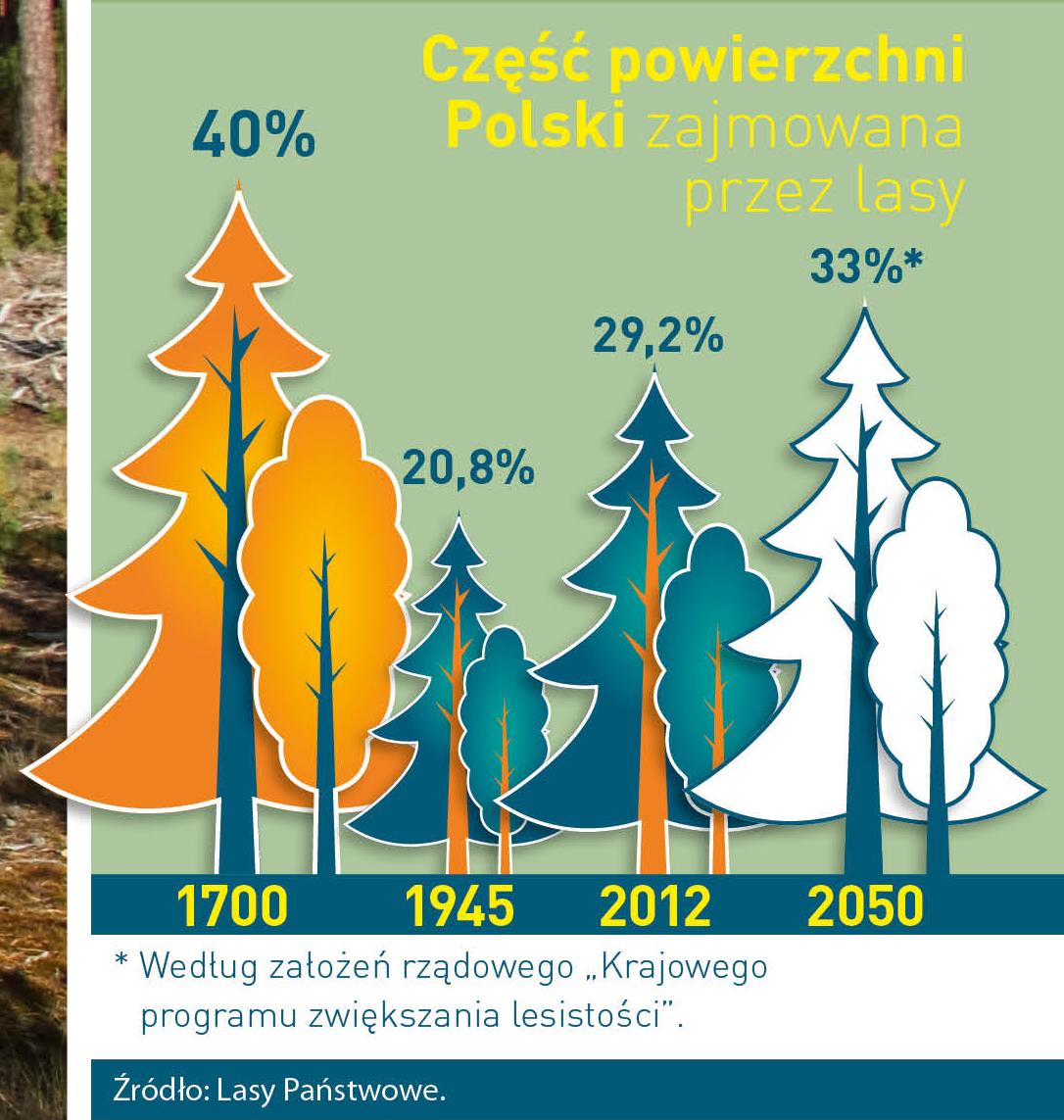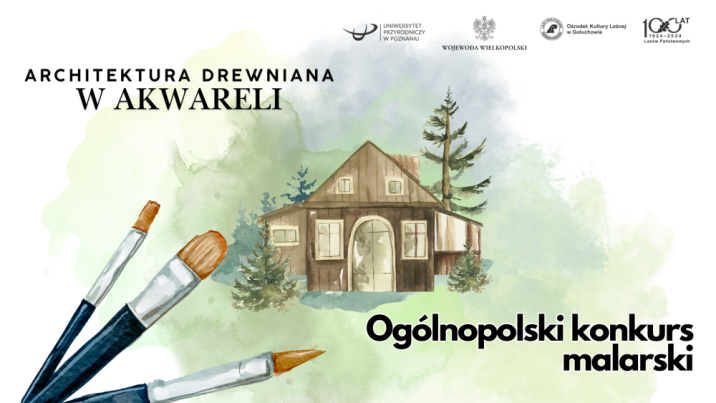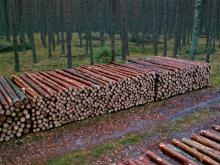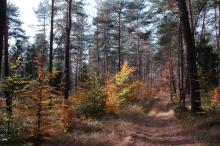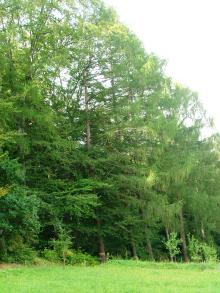 Asset Publisher
Asset Publisher
Polish forests
Poland is in the European lead, while concerning the area of all forests. They cover about 29,2 % of the country territory, and grow within the area of 9,1 million hectares. The overwhelming majority of the forests is state owned, of which almost 7,6 million hectares are managed by the State Forests National Forest Holding..
The number of Polish forest is still growing. The forestation rate of the country has increased from 21 % in 1945 to 29,2 % at the moment. Between 1995 and 2008, the forest area increased by 310 thousand ha. The basis for afforestation works is the "National Programme for Increasing the Forest Cover" (KPZL), assuming an increase of the forestation rate up to 30 % by 2020 and up to 33 % by 2050. Polish forests abound in flora, fauna and fungi. 65 % of the total number of animal species live there.
The forests grow in our country on poor soils, mainly because of the development of the agriculture in previous years. It influences the distribution of the types of the forest sites in Poland. Over 55 % of the forest areas is covered with coniferous forests. In other areas, there are forest sites, mainly the mixed ones. Their small part constitute alder and riparian forests – not more than 3 %.
In the years 1945 – 2011 the area of natural deciduous tree stands within the area of the State Forests National Forest Holding increased from 13 to 28,2 %.
Within the lowlands and uplands the most often occurring tee species is pine. It covers 64,3 % of the forest area of the State Forests National Forest Holding and 57,7 % of private and commune forests. In the mountains the predominant species is European spruce ( in the west) and European spruce with beech (in the east). Domination of pine is the result of carrying on sustainable forest management in the past. Once, the monocultures (crops or cultivations of one species) were the answer to the great demand of industry for wood. Such forests appeared to be quite fragile to climatic factors. They also were often the prey of pests' expansion.
In Polish forests, the share of other tree species, especially deciduous trees have been systematically increasing. The foresters have stepped aside from monocultures – that is why, they try to fit specific species of the forest stand to the natural stand, that would be proper for the given area. Thanks to that, in the years 1945 – 2011, the area of the deciduous tree stands within the lands of the State Forests National Forest Holding increased from 13 to 28,2 %. There occur more and more frequently the following tree species: oaks, ashes, maples, sycamore maples, elms, but also birches, beeches, alders, poplars, hornbeams, aspens, tilias and willows.
Our forests are the most often represented by the forest stands aged 40 to 80 years. The average age of the forest equals 60 years. More and more trees are of big size at the age over 80 years. Since the end of the Second World War, the forests' area has increased up to almost 1,85 million hectares.
Raport o stanie lasów w Polsce 2012
 Asset Publisher
Asset Publisher
Ogólnopolski konkurs malarski "Architektura drewniana w akwareli"
Ogólnopolski konkurs malarski "Architektura drewniana w akwareli"
Wydział Leśny i Technologii Drewna Uniwersytetu Przyrodniczego w Poznaniu, Wielkopolski Urząd Wojewódzki w Poznaniu oraz Ośrodek Kultury Leśnej w Gołuchowie zapraszają wszystkich miłośników sztuki do udziału w Ogólnopolskim konkursie malarskim „Architektura drewniana w akwareli”.
Celem konkursu jest promocja drewna jako materiału konstrukcyjnego i dekoracyjnego oraz ukazanie jego piękna poprzez technikę akwareli. Tematem konkursu są drewniane budynki oraz różnego typu drewniane budowle obecne w krajobrazie Wielkopolski. Mogą to być zarówno obiekty istniejące, zabytkowe i współczesne, jak i będące wytworem wizji artystycznej autora inspirowanej regionem. Prace mogą przedstawiać różnego typu obiekty, jak np. wielkie konstrukcje drewniane, budynki sakralne, wiejskie chaty, przydrożne kapliczki, rzeźby, ornamenty i ozdoby, czy przedmioty użytkowe. Ważne, żeby istotnym motywem pracy było przedstawienie drewna jako materiału konstrukcyjnego, dekoracyjnego, czy twórczego.
Kto może wziąć udział?
Do udziału zapraszamy wszystkich pełnoletnich pasjonatów malarstwa: artystów plastyków, grafików, projektantów, a także osoby, które po prostu kochają akwarelę. Konkurs ma charakter otwarty i bezpłatny, a każdy uczestnik może zgłosić od jednej do trzech prac.
Zasady konkursu
-
Termin nadsyłania prac: do 31 sierpnia 2025 roku;
-
Rozmiar pracy: dowolny, jednak autorzy powinni uwzględnić możliwość zaprezentowania ich na planszach wystawowych o rozmiarach A0 (84,1 cm × 118,9 cm);
-
Forma zgłoszenia: Prace należy przesyłać w formie zeskanowanych plików graficznych (JPG) na nośniku elektronicznym;
-
Adres do nadsyłania prac: Uniwersytet Przyrodniczy w Poznaniu, Dziekanat Wydziału Leśnego i Technologii Drewna, ul. Wojska Polskiego 28, 60-637 Poznań, z dopiskiem: „Architektura drewniana w akwareli”. Do zgłoszenia należy dołączyć wypełniony załącznik nr 1 (Formularz zgłoszeniowy) oraz podpisany załącznik nr 2 (Zgoda RODO).
Nagrody
Na zwycięzcę czeka nagroda rzeczowa o równowartości do 2000 zł w postaci materiałów plastycznych. Najlepsze prace zostaną zaprezentowane na specjalnej wystawie pokonkursowej. Fundatorem nagrody jest Wielkopolski Urząd Wojewódzki w Poznaniu.
Więcej informacji oraz niezbędne dokumenty znajdują się na stronie https://wltd.up.poznan.pl/pl/blog/zaproszenie-do-udzia-u-w-og-lnopolskim-konkursie-malarskim-architektura-drewniana-w-akwareli


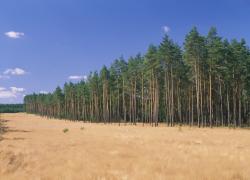 fot. Paweł Fabijański
fot. Paweł Fabijański
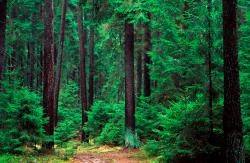 fot. Paweł Fabijański
fot. Paweł Fabijański
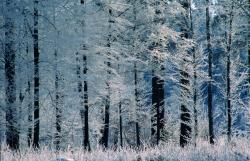 fot. Paweł Fabijański
fot. Paweł Fabijański
